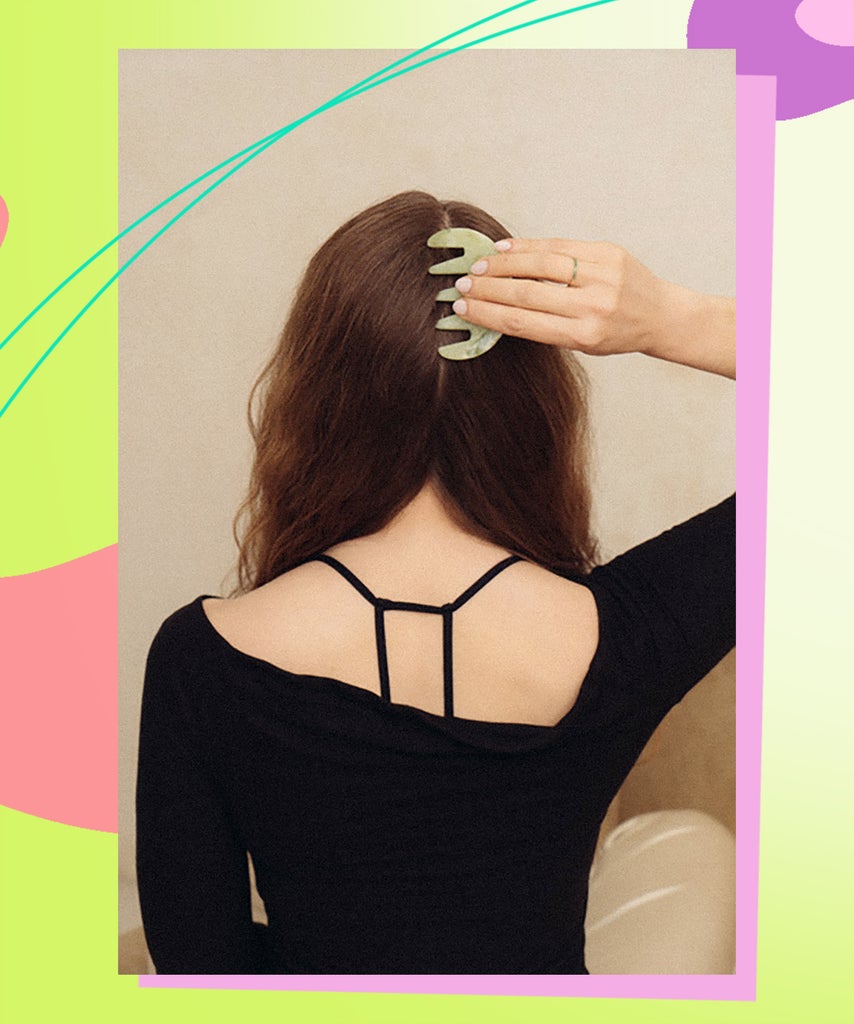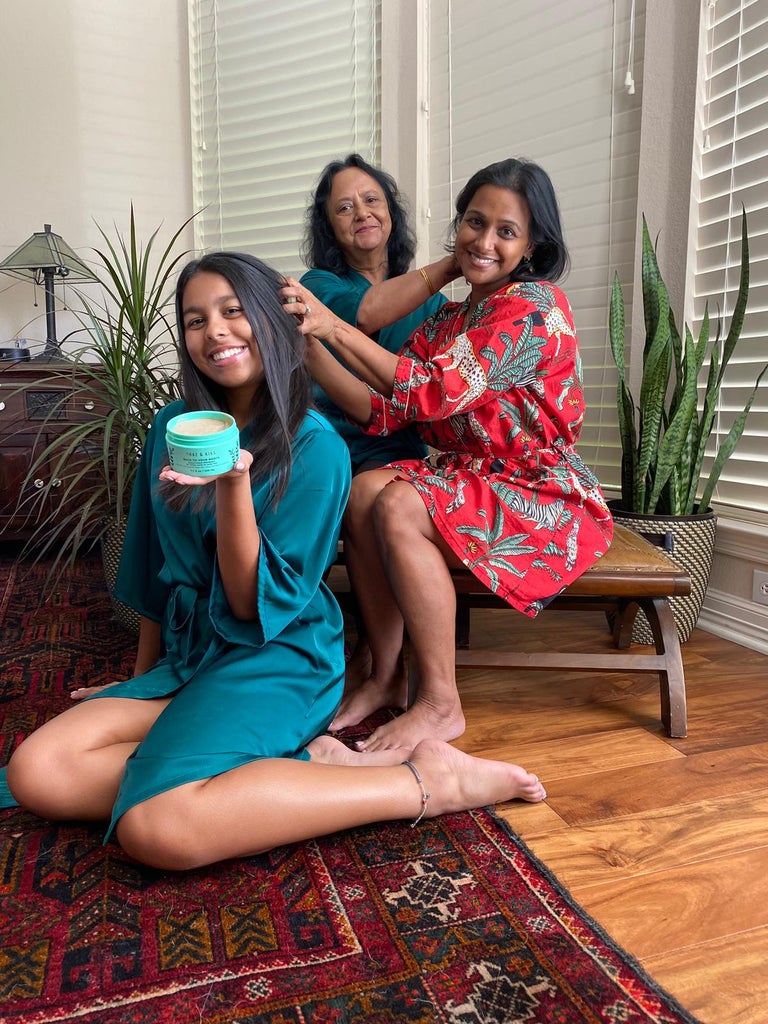When Kiku Chaudhuri, one-half of the sister-founded hair-care brand Shaz & Kiks, reads a headline about “hair slugging” with no mention of the traditional Indian hair oiling practice it’s borrowed from, she can’t help but roll her eyes.
Sandra Lanshin Chiu, L.Ac., Traditional Chinese Medicine practitioner and founder of skin-care tools brand Lanshin, knows the feeling. For years, the Chinese medicine practice of gua sha has been coopted by American retailers that profit off the “trend” without taking the time to learn its history.
Their shared experience with seeing their cultures’ age-old practices adapted by Western brands to suit a Western audience brought Chiu and Chaudhuri together to partner up and create a hair-care system — a tool and a pre-wash treatment — that would honor their respective traditions. The ritual is a marriage, they explain, between Traditional Chinese Medicine (TCM) and Indian Ayurveda.
In America, our standard operating procedure is to lather up with shampoo in the shower, then rinse it out. Travel to China or India, and you’ll see that women treat their scalp first, with thorough massage and topical application of medicinal herbs they swear by for healthy, shiny hair. Chiu and Chaudhuri wanted to share the Eastern wisdom of scalp care — which promises benefits beyond strong hair, like plumper skin and tension relief (if you’re stressed, keep reading) — but with the utmost cultural respect.
“When we look at the space of beauty, so many of the traditions that are being taught or sold we recognize as part of our cultural background, our childhoods,” explains Chiu. “We weren’t seeing people who actually root from that representing. It [felt] like a big hole.”
The History of Scalp Care in Eastern Tradition
So, let’s start with understanding scalp care from an Eastern perspective. There are a few important points that Americans often miss: a focus on encouraging blood circulation, the familial bonding ritual, and the application of nutrients onto dry hair.
Chiu grew up in America but visited her relatives in Taiwan as often as her family was able. There, she was introduced to the concept of scalp massage and its importance for circulation, a cornerstone of TCM. In Taiwan, Chiu explains that her hair was never washed in the home, but instead at a nearby salon where massage was an integral part of the experience. “It was epic,” she recalls. “They sat me down in the chair and started with what’s called a ‘chair shampoo’ where they squirt shampoo in [my] hair, dry, and then they start spraying water, gradually foaming it with scalp and neck massage — it’s, like, 10 to 15 minutes long.”

The massage wasn’t aimed at giving the women “good hair” (that’s an Americanism) but to boost general circulatory health. “What’s important in Asia is not just the hair, but the root of the hair,” Chiu says. “In Asian culture, we’re obsessed with circulation. When you think about health, the first thing you think about is circulation.”
The Indian hair-care tradition is also rooted in circulation, but varies from that of Chiu’s in that it’s at-home ritual — and hair oil is applied to the scalp before the massage as a pre-shampoo. “Every morning our grandmother would create different oil-based formulas by hand,” Chaudhuri explains. The oils are made with Ayurvedic garden herbs and flowers, natural blood stimulators that increase the circulation, so your scalp is able to absorb the ingredients you’re massaging in.
In India, champi, or ritual hair massage, served as a beautiful experience for Chaudhuri and her sister (the Shaz half of Shaz & Kiks) to share with their mother and grandmother. “We’d all sit around in the morning and Grandma would create a hair-oil mask that we’d put on dry hair before doing the wash routine,” she says. “I can still close my eyes and remember my grandmother’s fingers on my scalp and in my hair.”
The Benefits of Scalp Stimulation

Here’s where I was floored by TCM: There are so many benefits of scalp massage that go beyond hair growth (which obviously takes time to see). Chiu likens the practice to gua sha for your skull. “The scalp has musculature and it gets tight, just like anywhere else,” she explains. “It can form little knots. This is particularly [common] near the temples and the side of the head, where we link into the jaw muscles.” (Hello, TMJ sufferers.)
We’re talking about physiology, but there’s also immediate aesthetic benefits that come with scalp massage. “When you work with gua sha on the scalp and you loosen up the scalp muscles, you’re thereby opening up the pathways of circulation,” Chiu says. “You will notice a change in how you feel pretty instantly. A lot of people will notice, ‘Oh, I’m working on my scalp, but my neck feels better, my jaw feels better, my eyes look more awake and open.’ You know how you leave a facial and your skin looks plumper? Scalp massage can give you that, almost instantly.”
If you weave in the Ayurvedic tradition of hair oiling with the TCM tissue massage, you’re getting the topical hair benefits as well. “You’re really able to condition your hair before you wash it, so when you put soap in, it doesn’t strip away the good oils,” explains Chaudhuri. “In the Western world, you jump in the shower and you’re stripping away a lot of your good, natural oils. In Ayurveda, you’re putting the conditioner in before, so it helps moisturize the hair, and then you shampoo. You’re getting rid of excess oils, yes, but your hair is not getting stripped of its natural oils, which is a big part of hair care that stems from Ayurveda.”
How to Do Scalp Care at Home
With their partnership, Chiu and Chaudhuri have made it easy for anyone to try scalp stimulation. The duo created an easy system: a Prewash scalp treatment, which is a paste packed with Ayurvedic herbs, and a handmade jade comb to stimulate the scalp. You simply apply the Prewash Mask to dry hair and use the comb to massage your scalp.
The Shaz & Kiks Prewash Mask pulls the benefits of traditional Indian hair oiling, and makes it a little less messy. “When my sister and I were creating this company, [we took] the things that we liked and [left] the things that we didn’t,” explains Chaudhuri. “I’ve been putting oil in my hair since I was two years old and the benefits are great, but the experience wasn’t. For many hair types, it’s hard to massage oil in and then wash it out. We took all the good ingredients and we made it into a lightweight cream — so your hair doesn’t look oily.”

As for the massage element, you can use your fingers, but the Lanshin Scalp Stimulator will make your massage more effective — it’s the same logic as gua sha. “There’s a lot of tool use in TCM,” explains Chiu. “Tools just add strength to the stimulation, because a stone is harder than a soft hand. There’s a difference when you stimulate with a tool vs. a finger. They’re both good, but we’re putting the maximum into this. The tool helps push the product into the hair follicle better and treat the scalp skin as well.” Not to mention that, in Chinese medicine and culture, jade is known for having healing energy.
According to Chiu, with these tools, it’s tough to get scalp stimulation wrong. “The techniques are easy; it’s just stimulating different points with the tool using circular motions,” she says. “You work around your head to places that feel good. Everyone has different spots on their head and neck that feel tight and uncomfortable, and all you have to do is work on them and open up the circulation.” She also has an instructional video that was really helpful for me.
My Experience
After speaking with Chiu and Chaudhuri, I was eager to try both the Prewash and the Scalp Stimulator. Sunday night, with dirty hair and an episode of Gilmore Girls on TV, I scooped out the Prewash paste and rubbed it into my scalp, first with my fingers, and then grabbed the comb.
The Prewash smells like turmeric and lemons, which I find very lovely. I’m not precious with the comb: I run it down my scalp and through my hair and immediately notice the “knots” Chiu was referring to and focus small circles in those areas. I’m in a trance until “Amy Sherman-Palladino” comes across the screen, signaling the episode’s end. I get in the shower and wash out the Prewash, then use my regular bumble & bumble shampoo to get everything out (as promised, the Prewash rinses out easily, with no residue).
I skipped to conditioner altogether and my hair air-dried light and soft — rarely my reality. In the days after, I used the scalp stimulator at my desk to knead out any back-of-the-neck knots. What’s more, I feel like I’m honoring a tradition that I only ever really half understood. “I am very sensitive to the concern of, Is it okay that I’m doing this if I’m white or not Asian?” Chiu offers. “Of course it’s okay! We’re sharing this with you. Appropriation is not directed at the consumer, but at the people who sell or teach things that they don’t know anything about because they’re not from a culture.”
Like what you see? How about some more R29 goodness, right here?
Battling A Bad Breakout? Chloë & Halle Can Help
How Tea Can Help Your Skin: Review Of Fresh Elixir
How To Beat The White Cast From Sunscreen
from Refinery29 https://ift.tt/r5beHlE
via IFTTT
